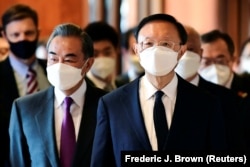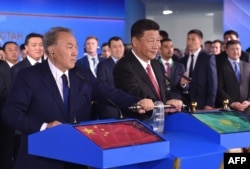While China and the United States are locked in an increasingly fierce rivalry, their growing competition will reflect differently across the countries of Eurasia, where those world powers share a separate strategic approach compared to other parts of the world.
The frayed ties between Beijing and Washington were on display in Alaska on March 18-19 as top U.S. and Chinese officials met for two days of talks that produced a public spat and showed no hope on the horizon for improved relations.
The first high-level, in-person talks between the world’s two largest economies since U.S. President Joe Biden took office began with sharp criticism by each side in opening remarks before the international media.
U.S. Secretary of State Antony Blinken, who was joined by national-security adviser Jake Sullivan, issued a litany of complaints against Chinese actions, including an increasingly militant posture toward Taiwan, its internment of Muslim minorities in its western Xinjiang Province, a brutal crackdown on democracy in Hong Kong, and the economic coercion of Australia.
Subscribe To Our New ‘China In Eurasia’ Newsletter
It has become impossible to tell the biggest stories shaping Eurasia without considering China’s resurgent influence in local business, politics, security, and culture.
China In Eurasia is the new monthly newsletter by correspondent Reid Standish in which he builds on local reporting from RFE/RL’s journalists across Eurasia to give you unique insights into Beijing’s ambitions. It’s sent on the first Wednesday of each month.
To subscribe, click here.
Yang Jiechi, a Politburo member and Chinese leader Xi Jinping’s most senior envoy, who represented Beijing in Alaska along with Foreign Minister Wang Yi, said the United States had a “Cold War mentality” and was trying to “incite” countries to attack China. He also leveled sharp criticism against U.S. officials for what he called race problems.
The fiery diplomatic episode laid bare the harsh stances Beijing and Washington have developed for one another and sent a message to other countries already navigating tensions between the world powers that they should prepare for an even more challenging environment in the coming years.
For the diverse countries of Eurasia — stretching from Eastern Europe into Central and South Asia — that calculus could be different.
While the area is home to an expanding Chinese economic and political footprint that many analysts believe will attract more attention and pushback from Washington in the future, the bulk of the growing friction between the two countries is focused on issues closer to China’s east — such as the South China Sea and growing tensions with Taiwan.
“Eurasia is not at the center of the U.S.-China competition,” Daniel Markey, a professor at Johns Hopkins University and a former State Department official focused on South Asia, told RFE/RL. “That doesn’t mean it won’t be an important region to watch, but the sharpest competition is playing out closer to China’s eastern shores, not its western backyard.”
Eastern Shores Vs. ‘Western Backyard’
To further highlight this focus, U.S. officials met with allies in Japan and South Korea in the run-up to the meeting in Alaska to reaffirm their ties and better coordinate on China matters, which both Tokyo and Seoul view as a top security issue.
At the meeting, Beijing took up a broad agenda that showcased the Chinese leadership’s increasing confidence around the world. China’s economy has withstood a trade war with President Donald Trump’s administration and has rebounded strongly from financial headwinds brought by the pandemic.
This assurance is in part due to China’s expanded presence over the last decade across Eurasia that has mostly come in the form of Beijing’s multibillion dollar Belt and Road Initiative (BRI), which has funded infrastructure projects across the broad region as a means to grow its political and economic sway.
The growing gravity through BRI-linked projects has made Eurasia into a geopolitical laboratory, with China becoming a leading development financier as state-owned Chinese banks backed costly building projects in risky markets — expanding Beijing’s influence and creating new opportunities for its companies as it invests in strategic locations like Pakistan’s Gwadar Port, rail links across Central Asia, and Iran’s vast but troubled oil sector.
“What Beijing is doing across Eurasia is significant and will be consequential if it can accomplish its goals, but that’s no easy feat,” said Markey.
While East Asia is still a region characterized by an American military presence and a constellation of U.S. allies, Eurasia is a complicated patchwork of countries that present a far less hostile policy environment for Beijing.
This is partially what motivated China’s westward expansion across the region in the form of the BRI: receptive governments eager for Chinese capital and a vast area where the United States has closed military bases and has drawn down its presence in Afghanistan.
“There has been a desire for China to avoid too much open confrontation with the West, which informs why Chinese strategies have pursued opportunities across Eurasia,” Edward Lemon, an expert on Central Asia at Texas A&M University, told RFE/RL. “China will continue to grow its role in the region, especially as the [United States] continues to pull out of Afghanistan.”
Eurasian Interests
American involvement, on the other hand, is far more disparate. While Iran is a top issue for the Biden administration, regions such as Central Asia are not a policy priority for Washington.
American interest and involvement in Central Asia have waxed and waned since the collapse of the Soviet Union, intensifying in the aftermath of the invasion of Afghanistan in 2001 and ensuing anti-terrorism military campaigns.
The region has once again received more attention as Washington increasingly views China and Russia as its two main rivals on the global stage, but Washington doesn’t look ready to compete with Beijing’s deep pockets and is unlikely to match Moscow’s commitment to engagement.
Locked Up In China: The Plight Of Xinjiang’s Muslims
Radio Free Radio/Radio Liberty is partnering with its sister organization, Radio Free Asia, to highlight the plight of Muslims living in China’s western province of Xinjiang.
One issue that could receive more attention amid growing tensions between Beijing and Washington is Xinjiang, where the Chinese government has reportedly imprisoned more than 1 million Uyghurs and other Muslim minorities in internment camps. The United States and other Western nations have become increasingly vocal about the camps, with the European Union agreeing on March 22 to sanction Chinese officials because of Beijing’s actions in Xinjiang.
In recent years, Beijing has built up its surveillance capabilities in its western region, which shares a border with Kazakhstan, Kyrgyzstan, and Tajikistan, and begun a brutal crackdown on the Turkic Muslim minorities.
The brunt of these efforts have focused on China’s Uyghur population, but Kazakhs and Kyrgyz have also found their way into the camps, which have damaged China’s image in the wider region.
In February 2020, then-Secretary of State Mike Pompeo focused his attention on China’s presence in Central Asia during a trip to the region, raising concerns about corruption, unsustainable debt, and abuses in Xinjiang. The harsh anti-China focus reportedly unsettled local governments who seek to avoid getting caught in the spats of larger powers and instead have aimed to use Washington’s more distant presence to help offset Beijing and Moscow’s substantial weight.
“Central Asia is not a battleground for the U.S.-China rivalry, but it’s not going to be easy [for it to not be involved] given that relations are so poor and competition [between the United States and China] is growing,” said Nargis Kassenova, a senior fellow at Harvard who focuses on China’s role in the region.
But despite the deepening rivalry between Beijing and Washington and a more difficult policy climate, neither side has much interest in changing their traditional approaches to Central Asia and beyond.
According to Kassenova, handling the growing pressures of the superpower conflict will be increasingly hard for small countries as they must also deal with Russia, which is growing closer to China as ties between Moscow and Washington reach historic lows.
Still, she says, the major external players have little interest in turning Central Asia or its neighbors into a new area of conflict with others simmering around the globe.
“There’s always been an appreciation for local sensitivities, and it is likely to remain this way,” she said.
PrintReid Standish | Radio Free (2021-03-23T06:48:05+00:00) World Power Bickering: Eurasia Hoping To Steer Clear Of U.S.-China Rivalry. Retrieved from https://www.radiofree.org/2021/03/23/world-power-bickering-eurasia-hoping-to-steer-clear-of-u-s-china-rivalry/
Please log in to upload a file.
There are no updates yet.
Click the Upload button above to add an update.




